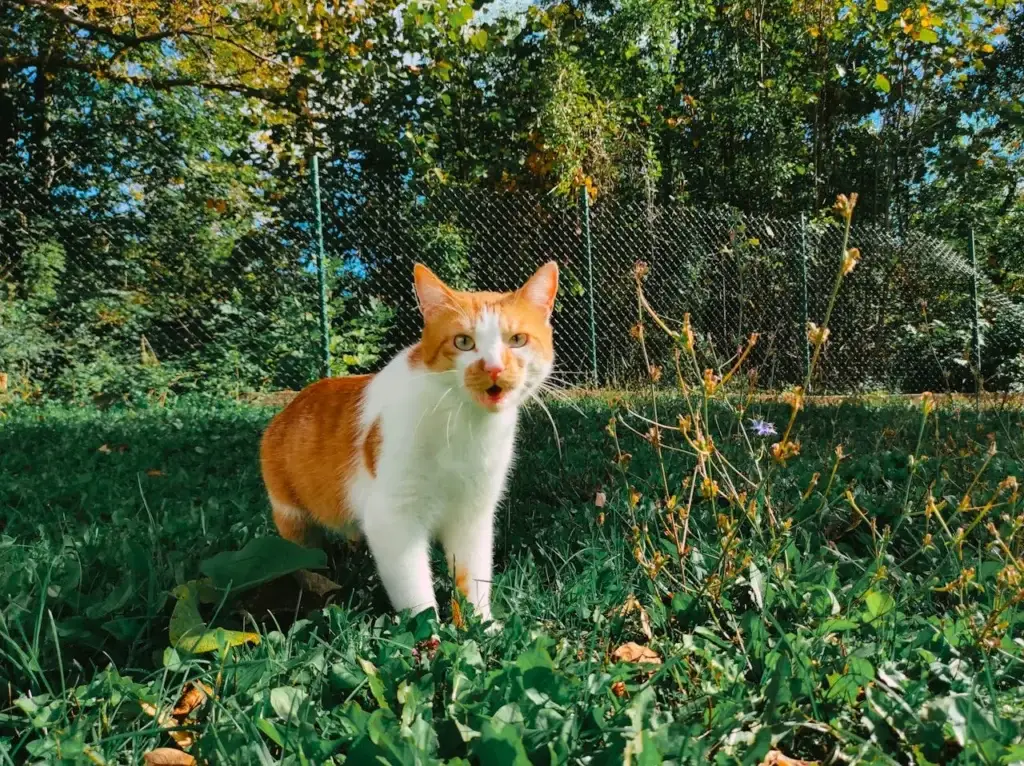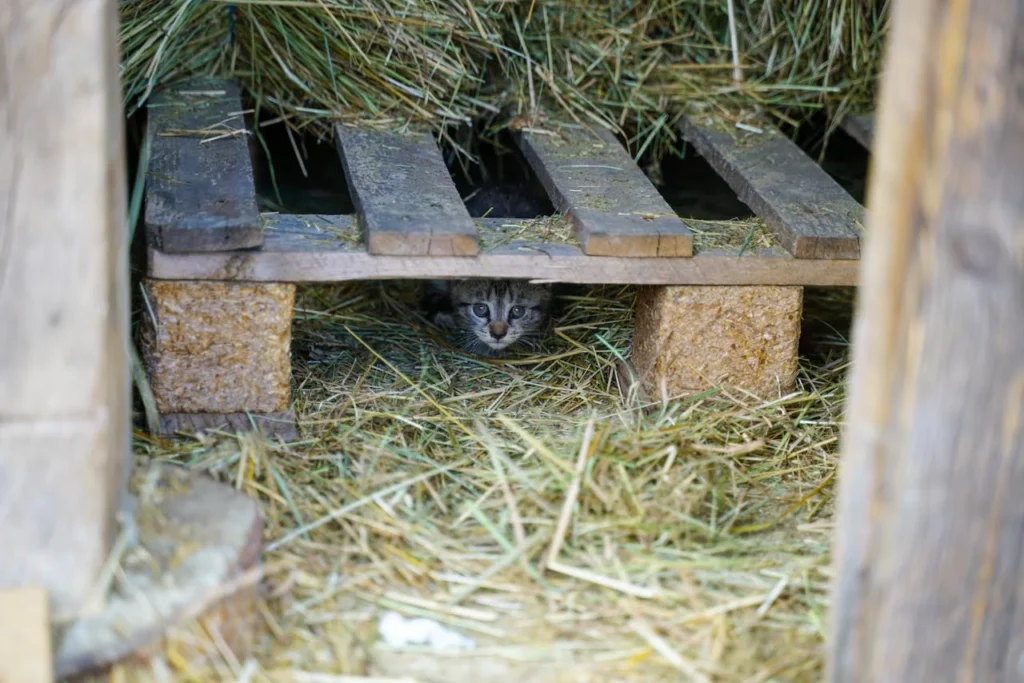I love cats and know the joys and challenges of caring for them outdoors. Outdoor cats face many issues, from being a nuisance to staying safe. But, with the right knowledge, we can solve these problems humanely.
This guide will help you, as a cat owner or caretaker, tackle common outdoor cat problems. You’ll learn about Trap-Neuter-Return (TNR) programs and how to keep your cats safe. You’ll also find ways to make your community a better place for everyone.
Dealing with outdoor cat issues can be tough. But, this article will give you the tools you need. We can work together to make sure outdoor cats are happy and healthy, while protecting our environment.
Understanding Outdoor Cats
What is an Outdoor Cat?
“Outdoor cat” refers to many domestic cats, like feral, community, stray, and alley cats. These names tell us about their behavior and how they live with humans. Knowing about these types helps us better meet their needs and solve their problems.
Feral Cats: These cats rarely interact with people and live in the wild. They are often scared of humans and hard to approach.
Community Cats: These cats live outside but get some care from people. They may be friendly and interact with humans a bit.
Stray Cats: Once pets, stray cats now live outdoors. They might be friendly but still lack a home’s safety and resources.
Every outdoor cat’s story is unique, whether they’ve always lived outside or recently moved there. Their well-being and community impact are important. By understanding the different types, we can better help them.
The Importance of TNR (Trap-Neuter-Return)
TNR stands for Trap-Neuter-Return. It’s a way to control community cat numbers and make life better for cats, wildlife, and people. It’s key to community cat programs, helping fight cat overpopulation and reduce shelter intake.
By neutering community cats and letting them go back home, TNR programs slow down cat population growth. They also cut down on cat problems and make the cats healthier.
TNR works well, as seen in Harrington, Delaware. After fixing and vaccinating 550 cats, nuisance calls dropped by 98%. In Minnesota, AHS has done about 6,000 TNR surgeries in ten years.
To lower feral cat numbers, it’s vital to neuter and return at least 70% of them. In the Twin Cities, over 200,000 TNR surgeries are needed yearly to reach this goal.
“Alley Cat Allies made TNVR common in the U.S. in the 1990s. The Feral Freedom program in Jacksonville, Florida, started in 2008.”
TNR doesn’t change the number of free-roaming cats. But it does lessen cat problems and makes the cats healthier. It also helps shelters by keeping cats in their homes instead of shelters.
In summary, TNR is vital for community cat programs. It’s a good solution to cat overpopulation and improves life for cats and wildlife.
Accessing Spay/Neuter Resources
If you’re caring for outdoor cats, you’re not alone. Many animal welfare groups and local governments have started TNR (Trap-Neuter-Return) programs. These programs help a lot by offering traps, low-cost spay/neuter services, and even food and volunteer help.
Using these resources can help the outdoor cats in your area get the care they need. This includes spaying, neutering, and vaccinations. It also helps keep the cat population under control and improves their health. Some benefits include:
- Reduced feline overpopulation: Spaying and neutering outdoor cats prevents unwanted litters and reduces street cats.
- Improved cat health: Sterilized cats are less likely to roam, fight, or get sick, making them healthier.
- Increased community support: TNR programs bring together local groups and people, creating a support network for outdoor cats.
To start, contact your local animal shelter, humane society, or animal control. They can tell you about spay/neuter options and help with food and volunteer support. By using these programs, you can really help outdoor cats in your community.
“Spaying and neutering is the single most important step in reducing the number of homeless cats and dogs.” – ASPCA
Identifying Lost or Stray Cats
Telling a lost cat from a stray or community cat can be tough. Yet, there are clear signs to help figure out if a cat outside needs help. Knowing these signs is key to giving the right and kind assistance.
Signs a Cat Needs Help
A cat that looks thin, sick, or hurt might need help. Strays often have dirty, matted fur, while pets are clean and groomed. A cat’s behavior can also tell you a lot. A friendly, curious cat is probably lost, while a scared, shy one is likely a stray or feral.
When and where you see a cat matters too. Strays are active all day, looking for warmth and shelter. Pets, on the other hand, stick to a routine. Cats that come alone to people or homes are usually strays, while pets roam freely.
If you find a cat in trouble, put it in a safe carrier. Check for a microchip and call your local animal shelter or humane society. They can help the cat by finding its owner or giving it medical care and a new home.
Only adopt a stray cat as a last choice. Make sure to follow local laws and waiting periods. This way, the cat’s original owner can find it. With patience and the right help, you can really help a lost or stray cat.
Outdoor Cat Issues
Outdoor cats can sometimes be a problem in neighborhoods. They might dig, urinate, or defecate in yards. They could also jump on cars or disturb the peace with late-night yowling.
These outdoor cat nuisance issues often lead to calls to animal control. But, using TNR strategies and humane deterrents can help. Also, talking to the neighborhood can make living together easier.
By fixing yard and garden damage or neighborhood conflicts, we can help. Showing we care about cat health and welfare is key. This way, we can manage the challenges outdoor cats bring.
| Outdoor Cat Nuisance Concerns | Humane Solutions |
|---|---|
| Digging in yards, urinating, or defecating | Utilizing motion-activated sprinklers, cover soil with citrus peels or coffee grounds, or providing designated litter boxes |
| Jumping on cars | Applying double-sided sticky tape or aluminum foil to discourage cats from accessing vehicles |
| Nighttime yowling or disturbances | Educating neighbors about the importance of TNR strategies and providing resources for humane deterrents |
By tackling these outdoor cat nuisance issues, we can create a better place. We can make sure both cats and people are happy and respected.
Deterring Cats from Unwanted Areas
Cats are curious and sometimes wander into places they shouldn’t. Luckily, there are many ways to keep them out without hurting them. You can use electronic devices or natural repellents to solve the problem. These methods help you keep cats away while caring for their well-being.
Leveraging Cats’ Senses
Cats have a strong sense of smell, with more receptors than humans. This can help keep them away from certain areas. Commercial repellents that smell like predators can work well. Natural options like citrus, coffee, vinegar, and certain essential oils also repel cats.
Creating Physical Barriers
Physical barriers can also keep cats out. Here are some ideas:
- Cat-proof fencing with slanted panels or rollers at the top
- Chicken wire, sharp-edged mulch, or eggshells to make surfaces unpleasant to walk on
- Motion-activated sprinklers that startle cats with sudden bursts of water
- Ultrasonic devices that emit high-frequency sounds irritating to feline ears
Using these humane deterrents together can teach cats to stay away from unwanted areas.

Keeping your outdoor space clean and free from attractants like bird feeders helps too. With a careful plan, you can solve neighbor problems and still care for cats.
Protecting Wildlife from Outdoor Cats
Outdoor cats are a big threat to wildlife. They have helped wipe out over 60 species of birds, mammals, and reptiles globally. In the U.S., cats kill up to 4 billion birds and over 22 billion mammals each year. In Canada, they kill between 100 and 350 million birds yearly.
In places like the Portland area, the problem is worse. This region has over 200 bird species, many facing habitat loss. Thousands of stray cats roam, hunting these birds and upsetting the ecosystem.
The Cats Safe at Home campaign aims to solve this. It involves groups like the Bird Alliance of Oregon and Multnomah County Animal Services. They work on spaying cats, keeping them indoors, and tackling cat overpopulation.
Cat owners can help too. They can join the Catio Tour to build safe outdoor spaces for their cats. These spaces let cats enjoy the outdoors without harming local wildlife.
By using TNR (Trap-Neuter-Return) programs and teaching cat owners to be responsible, we can lessen the harm. This way, cats and native species can live together peacefully in the Portland area.
“Cats have contributed to the extinction of over 60 species of wild birds, mammals, and reptiles worldwide.”
Safeguarding Outdoor Cats
Protecting Cats from Predators and Harsh Weather
Outdoor cats are smart and often find safe spots when danger comes. But, they still face risks from predators and bad weather. You can help keep your outdoor cats safe by taking steps to protect them.
One key way is to give them good shelter. Cat enclosures, or “catios,” are great. They let cats enjoy the outdoors safely. Make sure their shelter is warm, dry, and well-ventilated, especially in cold weather.
Watching your cats for signs of trouble is also important. Make sure they have clean water and food. To keep predators away, like coyotes, you can use safe spots and motion-activated lights or sprinklers.
By focusing on your outdoor cats’ safety, you help them live better outdoors. This reduces the dangers from predators and bad weather.

| Outdoor Cat Safety Measures | Description |
|---|---|
| Enclosed Cat Enclosures (Catios) | Provide a secure and comfortable space for outdoor cats to enjoy the outdoors while being protected from the elements and potential predators. |
| Shelter from Harsh Weather | Ensure outdoor cats have access to warm, dry, and well-ventilated shelters, especially during cold winter months. |
| Predator Deterrents | Utilize strategies like creating safe havens and motion-activated deterrents to discourage predators from entering the outdoor cat’s territory. |
| Monitoring and Care | Regularly check on outdoor cats for signs of distress or illness, and ensure they have access to clean water and a reliable food source. |
By taking these steps, you can keep your outdoor cats safe. This ensures their well-being and happiness.
Outdoor Cat Issues
In the United States, there are an estimated 30 to 40 million outdoor cats. Many are abandoned or lost, while others are from uncontrolled breeding. This overpopulation causes problems, like conflicts with neighbors and harm to wildlife.
Outdoor cats can harm the environment. They prey on birds and small mammals, upsetting local ecosystems. To fix this, we need responsible pet owners, effective solutions for nuisance issues, and Trap-Neuter-Return (TNR) programs.
Outdoor cats can also cause trouble with neighbors. Issues like cat abandonment, wildlife impacts, and neighbor conflicts happen when cats roam. We can solve these problems with humane deterrents and better communication.
The outdoor cat population and cat overpopulation are big challenges. They need a team effort from pet owners, community groups, and local governments. With responsible pet care, TNR programs, and good solutions, we can live better with outdoor cats and our environment.
“Outdoor cats face a variety of health risks, including exposure to parasites, infectious diseases, and the potential for injury or even death from traffic accidents or fights with other animals.”
While outdoor cats offer some benefits, like exercise and mental stimulation, the dangers are greater. Pet owners should weigh the risks and benefits. They should look for safer options for their cats and the community.
Conclusion
Dealing with outdoor cats needs a caring and complete approach. Understanding TNR programs, spay/neuter services, and humane ways to keep cats away is key. This helps cat owners and caretakers manage outdoor cat numbers and keep peace in their communities.
It’s vital to think about the health of outdoor cats, wildlife, and neighbors when solving these problems. Education, teamwork, and a dedication to responsible cat ownership are crucial. This way, we can tackle the issues of outdoor cats and make things better for everyone.
By joining forces to tackle outdoor cat issues with humane cat care and community cat management, we can protect both cats and people. We also safeguard local wildlife. With kindness and teamwork, we can make a positive change for all.
FAQ
What is an outdoor cat?
An outdoor cat can be feral, tame, community, stray, or an alley cat. These terms describe how a cat acts around people and where it lives.
What is TNR and why is it important?
TNR stands for Trap-Neuter-Return. It’s a way to manage outdoor cat populations. It helps cats, wildlife, and people by reducing cat numbers and improving their lives.
How can I access spay/neuter resources for outdoor cats?
Many animal groups and local governments offer TNR programs. They help with spaying/neutering, provide food, and offer volunteer support. They also lend traps and connect you with low-cost services.
How can I identify if a cat is lost, stray, or part of a managed community cat colony?
It’s hard to tell if a cat is lost or part of a community program. Look for signs like thinness, sickness, or injury. Always follow safe steps to help a cat and avoid disrupting TNR programs.
How can I address nuisance concerns caused by outdoor cats in my neighborhood?
Strong TNR programs and humane deterrents can help. They also encourage neighborhood cooperation. By showing responsible cat care, you can reduce conflicts and create a peaceful environment.
What are some humane deterrent strategies for keeping outdoor cats away from unwanted areas?
Use cat-proof fencing, motion-activated sprinklers, and ultrasonic repellents. Natural deterrents like citrus or sprays also work. These methods teach cats to stay away without harming them.
How can I protect local wildlife from outdoor cats?
Secure garbage, keep feeding areas clean, and place bird feeders safely. TNR and responsible cat care reduce wildlife harm. This helps protect birds and other animals.
How can I safeguard outdoor cats from predators and harsh weather?
Provide shelter, food, and water for outdoor cats. Use enclosed areas or “catios” for safety. Monitor them for signs of trouble. Protect them from coyotes with deterrents and safe zones.

Outdoor Cat House, Waterproof Outdoor/Indoor Cat House,Cat Houses for Outdoor Feral Cats,with Visible Window,Collapsible Warm Stray Barn Feral Cat Shelter (Army Green

